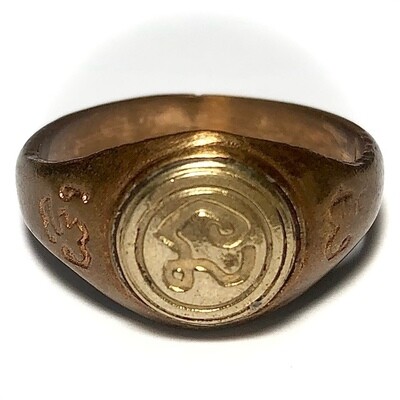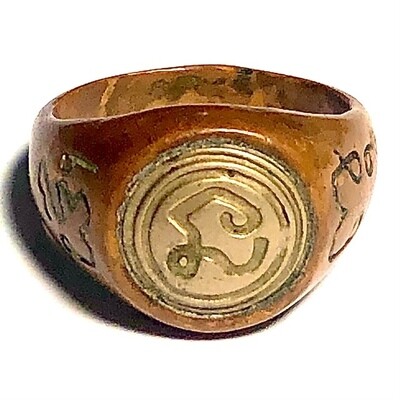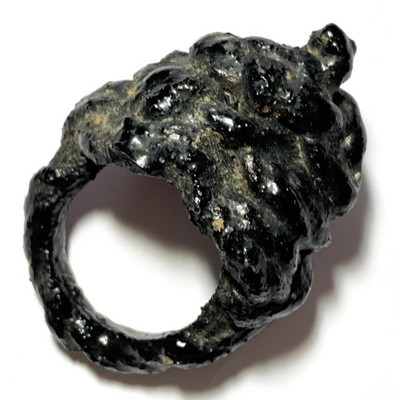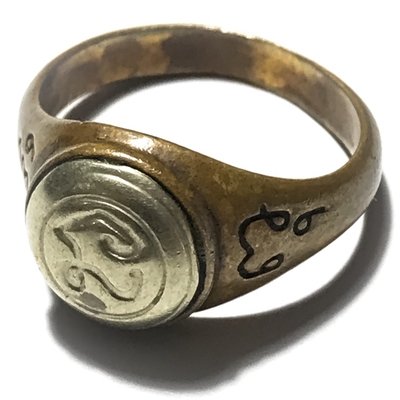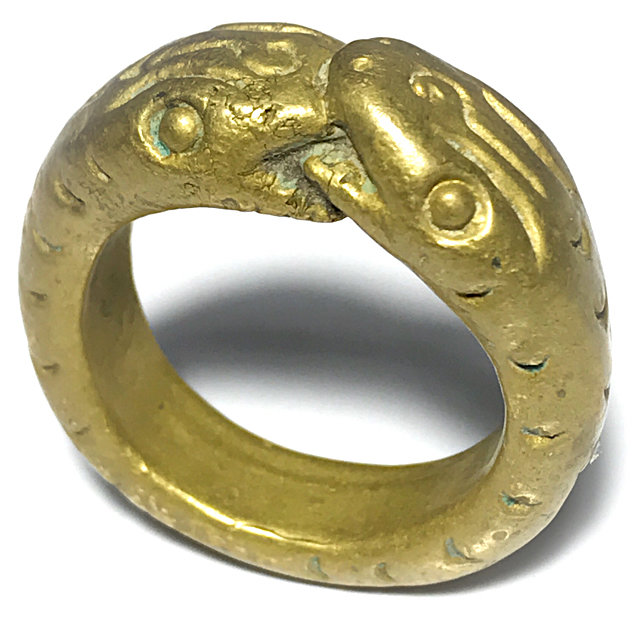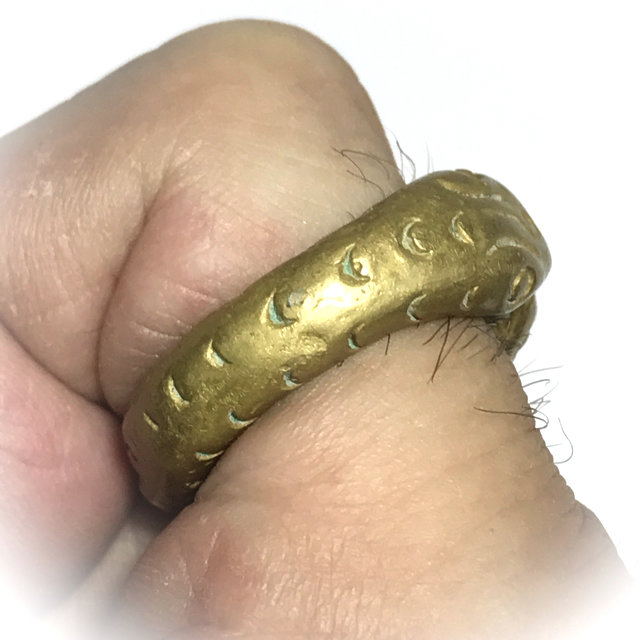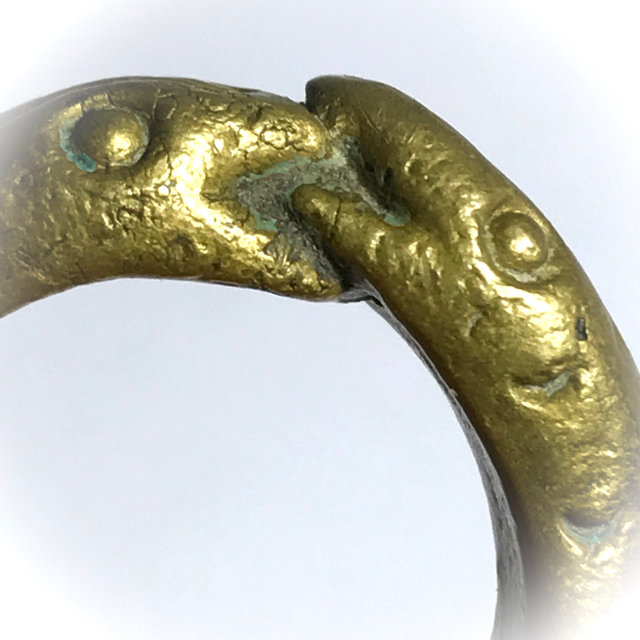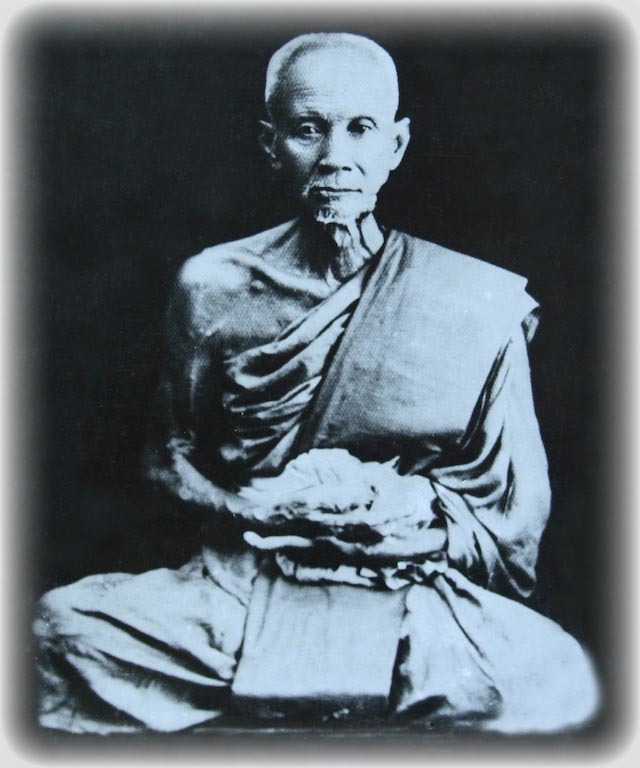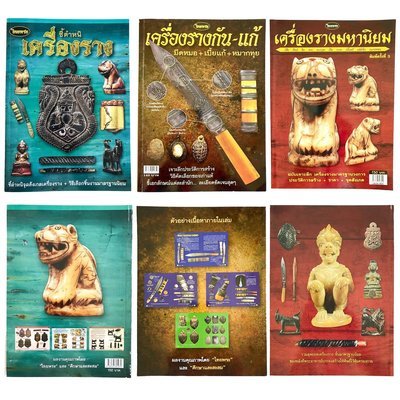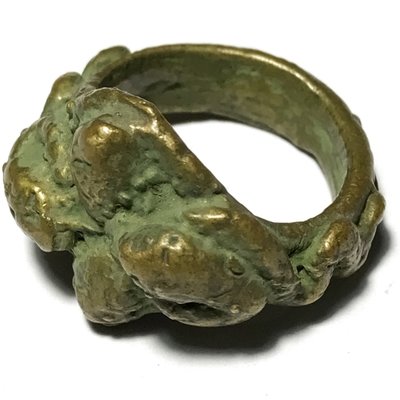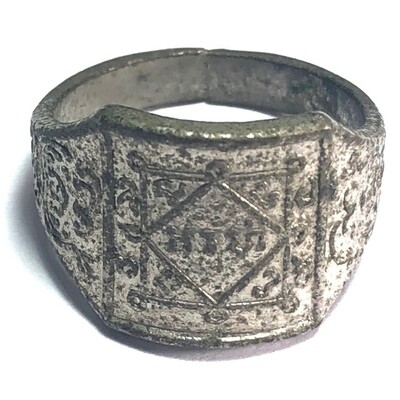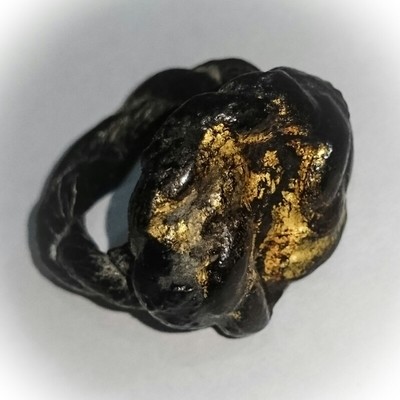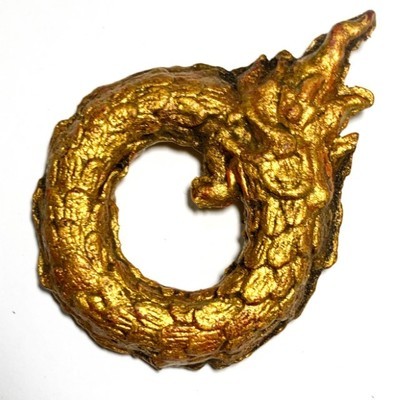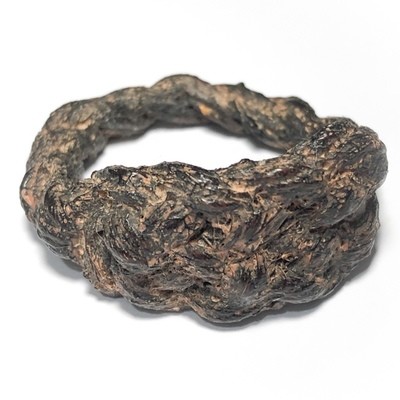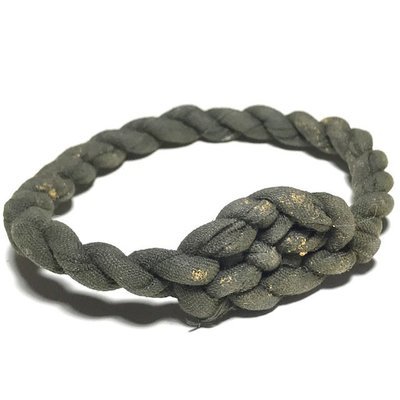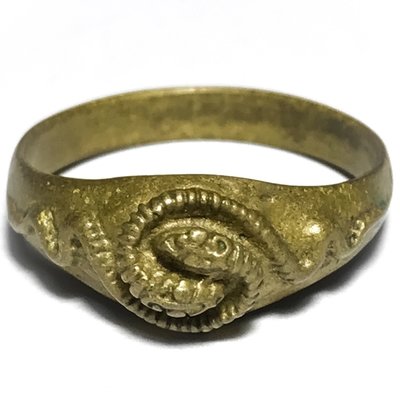A pristinely kept and extremely rare Rian Mangorn Koo Nuea Nava Loha Pim Pised Dtok Sorng Code Ma Wat Pha Nong Lom Run Sao Ha Maha Sethee 5th Lunar Saturday Blessing Ceremony Edition Guru Monk Coin, released in 2543 BE, to raise funds for the Kuti Songk Monks Huts and improve the facilities at the temple of Wat Pha Nong Lom.
This model of Rian Mangorn Koo twin dragons Monk Coin is a very rare Pim Pised (Niyom preferred) and differs from the majority of Rian Mangorn Koo Wat Pha Nong Lom Edition coins in Nava Loha, because of the double code MA stamp. Most coins of the Nava Loha series made for Wat Pha Nong Lom have only a single code Ma Stamp (on the Sangkati chest sash of the robe of Luang Phu), and only the Pim Pised special models received double code stamps. Only very few (unknown number) were distributed with double code stamp, making this not only a sacred, powerful master class amulet, but also a rare collectors piece.
The Rian Mangorn Koo of Luang Phu Hmun is, as are all of his amulets, known for the power of Jaroen Lap Wealth Increasement, and Lucky Fortunes, as well as for their Miraculous Protective Powers. Those born in the year of the dragon love to Bucha this amulet especially, for the obvious reason of the double dragon guardians.
For those with lower budgets, who seek power above collectability and rarity, we recommend to seek the Rian Mangorn Nuea Tong Daeng or Nava Loha single Code Ma, of the same edition, which carries a lower price than this special Nava Loha Pim Pised Gammagarn double code collectors edition model.
Hwaen Ngu Giaw Lor Boran Magic Serpentine Ring of Protection Wealth & Treasure 2460 BE - Luang Por Im - Wat Hua Khao
A heavy cast piece of alchemical metallurgy in the form of a wearable amulet, the Hwaen Ngu Giaw Sap Lor Boran Magic Serpentine Ring of Wealth, treasure and Protection, from Luang Por Im, of Wat Hua Khao. A truly olden days ancient amulet, forged using the ancient methods of Alchemical Mettalurgy. Luang Por Im was an olden days Guru Master, born over 150 Years ago, in 2406 BE, and who passed away more than 70 years ago in 2480 BE.This ring measures 2 Cm Inner Diameter.
He was extremely famous for his Takrut, Magic Rings, Nang Kwak, and other 'Lor Boran' ancient style cast metal amulets using alchemical metallurgy. Luang Por Im was known as the Koo Suad, who assisted the great Luang Por Mui, of Wat Don Rai (a great Buddhist master in his own right), in his ordinations as a Buddhist Monk.
The ring is forged in a thick heavy duty gauge, and is very sturdy, made with the true olden days casting method, as was ubiquitous in those days, and is befitting an ancient amulet of this calibre. The ring is estimated to have been made sometime between 2460 and 2470 BE. The Hwaen Ngu Giaw Sap is very old and rare, and is famous for its protective power against snake bites, and its powerful Maha Pokasap magic to attract and retain wealth and treasures. This exhibit is in extremely well kept condition and is a pristine example.
A very rare and highly preferred magic alchemical metal ring using the Wicha Ngu Giaw Sap (snakes entwined around treasures), from Olden Days Miracle Monk, Luang Por Im, of Wat Hua Khao. The Hwaen Giaw Sap is forged from a highly sacred and powerful admixure of alchemical metals and sacred artifacts.
Forged using ancient alchemical formulas of metallurgy and empowered with the incantations of the ancient sorcery grimoires of the lineage of Luang Por Im, the Hwaen Ngu Giaw is a famously powerful ancient amulet of high repute. The ring itself is formed into the shape of two snakes entwined, in ancient primitive style of bygone eras, and exudes an aura of power through the alchemical metal substance. Famous for Maha Pokasap and its power to protect.
Luang Por Im of Wat Hua Khao, was amn extremely powerful sorceror monk of olden days, whose miracles are legendary to this day. The miracle of the Sala Yai large Dhamma Salon Building was a very well known legend, which tells of the old Sala, being visited by a group of elephant herders with 5 elephants.
The herders came and parked their herd next to the Sala, which at that time had only small wooden pillars holding up a grass-hut style roof. The temple orphans saw the herders and approached to see the elephants. But they then saw something very strange happening; The herders were placing ice on the floor, and perched a cooking pot over the ice, and began to boil rice over it!
The temple orphans ran to the Kuti of Luang Por Im, and told him about this strange sight. Luang Por Im then told them that the herders were from Surin, and had powerful sorcery, and had conjured up an ilusion to hide the fact that they were using one of the wooden pillars of the Sala building to buirn and cook their rice. he then asked the temple orphans to go and bring him a coconut shell. He took the shell, and used it to sweep the floor of his Kuti with, and then told the orphans to go and check back at the Sala, to see what had happened.
The Orphans ran to the Sala, but the elephants were no longer there! When they ran back to see Luang Por Im, they saw the elephant herders bowing to Luang Por Im, and apologizing, admitting their wrongdoing, and asking for their elephants back! Luang Por Im then forgave them and gave them the command that next year, they should return and bring Luang Por Im ten large tree trunks to use as the new pillars of a bigger and better Sala he would build. This is then how the large Sala building at Wat Hua Khao, with its ten ten-ton wooden pillars, came to be built, through the miracle of Luang Por Im.
Another miracle which brought Luang Por Im to world fame, was the 'Miracle of Hnang Hinaw' (slippery skin). There were two enemies known as Ta Hnid, and Ta Pan, who decided to have a duel with swords to the death. Ta Hnid was known to have only one testicle, which is believed to bring Kong Grapan Chadtri Invincibility against blades and projectiles. Ta Pan was the nephew of Luang Por Im. The two enemies met behind the Uposatha Shrineroom of the temple at Wat Hua Khaom and using sharp swords, began to fight.
They stabbed and cut at each other without restraint, but no matter how many times they hit the mark with each other, nobody was hurt or cut, by a single blow! In the end they became so tired, and still unable to harm each other, that they gave up, and sat down together in truce, and drank some water. They talked and concluded that each of them must have something special protecting them. Ta Hnid admitted he has only one testicle and was empowered by nature with Kong Grapan Chadtri.
He asked Ta Pan what his secret was, and Ta Pan said that the only thing he had on him was the single Takrut he had received from his Uncle Luang Por Im. The two became friends forever, and close devotees of Luang Por Im, and the Takrut of Luang Por Im became a legend thereafter.
Luang Por Im once had a Looksit (Devotee), who liked to play in Aiamese Fighting Fish Competitions, but who had never won a single competition. He complained about this to Luang Por Im, who told the devotee to go and bring him some Bai Jag Papyrus leaves. The devotee came back with some papyrus leaves for Luang Por Im, who took them, and folded them into the form of a Siamese Fightiing Fish.
He then took the leaf origami fish, filled a bottle with warer, and dropped the origami fish into the bottle. To the total suprise of the devotee, the origami fish came to life and started swimming around in the bottle! Luang Por Im gave the bottle to the devotee and told him to take it to competition, which he did. He won the competition, and took his winnings and the fish home with him.
When he got home, he decided to place the fish in a different bottle, and took it out with a net. But as soon as the fish rose above water, it turned back int a folded Bai Jag leaf origami fish. This was yet another amazing miracle of Luang Por Im.
There was another story of the time that Luang Por Im came into the monks refectory and told them to hurry up and finish eating their alms, because they were needed to help to bring water to douse out a house fire.
The monks asked Luang Por Im what was going on? Luang Por Im told them then, that the night before, some local villagers had broken into the temple grounds to steal fish from the ponds, and that because of this, their houses were going to set on fire today. The monks then ate their food quickly wondering what Luang Por Im was talking about, and as they left the refectory, were surprised to hear a sudden arousal of people shouting 'Fire, Fire', and the monks realised that Luang Por Im had foreseen the event with his psychic powers.
Luang Por Im was ordained way back in the year 2426 BE, and became a solitary Tudong Forest Wanderer Monk, who traveled thrroughout the country learning Wicha with many forest Masters along the way, until he came upon a place of great peacefulness and solitude, at the foot of the Hua Khao Mountain in Supanburi Province. he decided to remain and build a temple there, which he named as 'Wat Hua Khao' and remained there as its first Abbot.
Luang Por Im was the Kroo Ba Ajarn of the great Luang Por Mui (Wat Don Rai), who spent one year with him at Wat Hua Khao, to learn the powerful Wicha Akom of this Great Supanburi Master Monk. Luang Por Im took Luang Por Mui to learn Wicha with the great Luang Phu Sukh, of Wat Pak Klong Makham Tao, who was a close friend and fellow sorceror monk with Luang Por Im.
Luang Por Mui also traveled often on Tudong forest wandering with Luang Por Im as his apprentice, and is considered his first Looksit and inheritor of his Wicha Akom Sorcery, along with Luang Por Khaeg (Wat Hua Khao), Luang Por Pui (Wat Kho), and Luang Por Song (Wat Sala Din).
Kata Aaraatana Pra Krueang
Hold the amulet to your forehead, and think of the Buddha, Dhamma and Sangha, and Chant;
Puttang Aaraatanaanang
Tammang Aaraatanaanang
Sangkang Aaraatanaanang
(Make Wish/Prayers)
Then Chant
Puttang Prasittimae
Tammang Prasittimae
Sangkang Prasittimae
